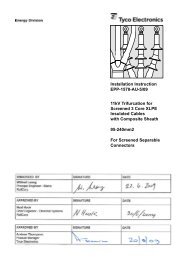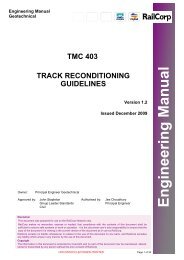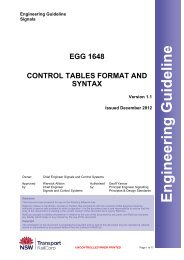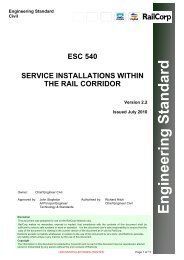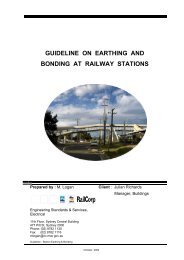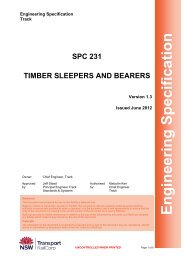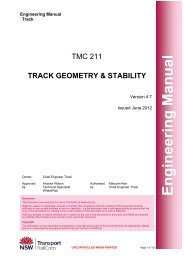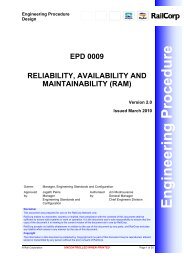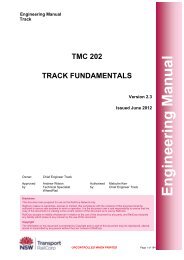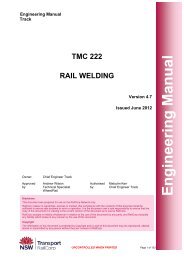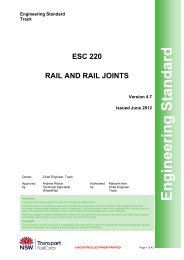Ballast - RailCorp Engineering Internet
Ballast - RailCorp Engineering Internet
Ballast - RailCorp Engineering Internet
Create successful ePaper yourself
Turn your PDF publications into a flip-book with our unique Google optimized e-Paper software.
<strong>Engineering</strong> Manual<br />
Track<br />
Owner: Chief Engineer Track<br />
Approved<br />
by:<br />
Andrew Wilson<br />
Technical Specialist<br />
Wheel/Rail<br />
TMC 241<br />
BALLAST<br />
Authorised<br />
by:<br />
Version 2.4<br />
Issued June 2012<br />
Malcolm Kerr<br />
Chief Engineer Track<br />
Disclaimer<br />
This document was prepared for use on the <strong>RailCorp</strong> Network only.<br />
<strong>RailCorp</strong> makes no warranties, express or implied, that compliance with the contents of this document shall be<br />
sufficient to ensure safe systems or work or operation. It is the document user’s sole responsibility to ensure that the<br />
copy of the document it is viewing is the current version of the document as in use by <strong>RailCorp</strong>.<br />
<strong>RailCorp</strong> accepts no liability whatsoever in relation to the use of this document by any party, and <strong>RailCorp</strong> excludes<br />
any liability which arises in any manner by the use of this document.<br />
Copyright<br />
The information in this document is protected by Copyright and no part of this document may be reproduced, altered,<br />
stored or transmitted by any person without the prior consent of <strong>RailCorp</strong>.<br />
UNCONTROLLED WHEN PRINTED Page 1 of 33<br />
<strong>Engineering</strong> Manual
<strong>RailCorp</strong> <strong>Engineering</strong> Manual — Track<br />
<strong>Ballast</strong> TMC 241<br />
Document control<br />
Version Date Summary of change<br />
1.0 October 2006 First issue as a <strong>RailCorp</strong> document. Includes content from<br />
C 2514, RTS.3648, RTS.3652, CTN 01/01, CTN 03/10<br />
2.0 April 2007 Additional reference; Addition of <strong>Ballast</strong> Quantities tables;<br />
Addition of restrictions on ballast stabiliser operation near<br />
bridges<br />
2.1 December 2009 Format changes<br />
2.2 July 2010 New Section C4-4 <strong>Ballast</strong> Sampling<br />
2.3 August 2011 C3 - Competencies updated for current National<br />
Competencies<br />
2.4 June 2012 Changes detailed in Chapter Revisions<br />
Summary of changes from previous version<br />
Summary of change Chapter<br />
Control changes Control<br />
Pages<br />
Reformatted to new template – Page numbering converted to continuous<br />
numbering. Separate document control on individual chapters removed<br />
New chapter “<strong>Ballast</strong> stockpiling” – includes content from CTN 12/04 5<br />
New chapter “<strong>Ballast</strong> sampling” moved from C4-4; inclusion of guidance on<br />
inspection on delivery; inclusion of examples of good and poor ballast – includes<br />
content from CTN 12/04<br />
Chapters renumbered<br />
© Rail Corporation Page 2 of 33<br />
Issued June 2012 UNCONTROLLED WHEN PRINTED Version 2.4<br />
All<br />
6<br />
7, 8, 9, 10,<br />
11, 12<br />
Updated content to reflect change to ESC 240 7<br />
C9-3 New section “Restrictions near signalling equipment” – establishes restrictions<br />
on operation of DTS near points<br />
9
<strong>RailCorp</strong> <strong>Engineering</strong> Manual — Track<br />
<strong>Ballast</strong> TMC 241<br />
Contents<br />
Chapter 1 Introduction......................................................................................................................4<br />
C1-1 Purpose .............................................................................................................................4<br />
C1-2 Context ..............................................................................................................................4<br />
C1-3 How to read the Manual ....................................................................................................4<br />
C1-4 References ........................................................................................................................5<br />
Chapter 2 Management Requirements ...........................................................................................6<br />
Chapter 3 Competencies..................................................................................................................7<br />
Chapter 4 Laying <strong>Ballast</strong> ..................................................................................................................8<br />
C4-1 Planning.............................................................................................................................8<br />
C4-2 Establish unloading rates ..................................................................................................9<br />
C4-3 Unloading procedure .........................................................................................................9<br />
Chapter 5 <strong>Ballast</strong> stockpiling.........................................................................................................13<br />
Chapter 6 <strong>Ballast</strong> sampling............................................................................................................14<br />
C6-1 At the quarry....................................................................................................................14<br />
C6-2 Site delivery.....................................................................................................................14<br />
C6-3 From stockpiles ...............................................................................................................14<br />
C6-4 In-track sampling .............................................................................................................14<br />
Chapter 7 Restoring ballast profile ...............................................................................................19<br />
Chapter 8 <strong>Ballast</strong> regulating ..........................................................................................................21<br />
C8-1 Machine application / operation.......................................................................................21<br />
C8-2 Machine capabilities ........................................................................................................21<br />
C8-3 Setting the plough blades................................................................................................21<br />
C8-4 Transferring ballast..........................................................................................................22<br />
C8-5 Profiling shoulders...........................................................................................................22<br />
C8-6 Brooming .........................................................................................................................22<br />
C8-7 The finished product........................................................................................................23<br />
Chapter 9 <strong>Ballast</strong> Stabilising..........................................................................................................24<br />
C9-1 Conditions required for effective stabilising of track........................................................24<br />
C9-2 Restrictions on or near structures ...................................................................................24<br />
C9-3 Restrictions near signalling equipment ...........................................................................24<br />
Chapter 10 <strong>Ballast</strong> cleaning .............................................................................................................26<br />
C10-1 Planning...........................................................................................................................26<br />
C10-2 <strong>Ballast</strong> Cleaning procedure .............................................................................................26<br />
Chapter 11 Track reconditioning using off track plant .................................................................28<br />
C11-1 Planning...........................................................................................................................28<br />
C11-2 Reconditioning procedure ...............................................................................................28<br />
Chapter 12 Loading Spent <strong>Ballast</strong> Wagons....................................................................................33<br />
C12-1 Material weights...............................................................................................................33<br />
C12-2 Checking for overloading.................................................................................................33<br />
© Rail Corporation Page 3 of 33<br />
Issued June 2012 UNCONTROLLED WHEN PRINTED Version 2.4
<strong>RailCorp</strong> <strong>Engineering</strong> Manual — Track<br />
<strong>Ballast</strong> TMC 241<br />
Chapter 1 Introduction<br />
C1-1 Purpose<br />
C1-2 Context<br />
This manual provides requirements, processes and guidelines for the installation and<br />
maintenance of ballast.<br />
The manual is part of <strong>RailCorp</strong>'s engineering standards and procedures publications.<br />
More specifically, it is part of the Civil <strong>Engineering</strong> suite that comprises standards,<br />
installation and maintenance manuals and specifications.<br />
Manuals contain requirements, processes and guidelines for the management of track<br />
assets and for carrying out examination, construction, installation and maintenance<br />
activities.<br />
The manual is written for the persons undertaking installation and maintenance activities.<br />
It also contains management requirements for Civil Maintenance Engineers and Team<br />
Managers needing to know what they are required to do to manage ballast installation<br />
and repair activities on their area, and production managers needing to know what they<br />
are required to do to manage the renewal activity their teams are undertaking.<br />
C1-3 How to read the Manual<br />
The best way to find information in the manual is to look at the Table of Contents starting<br />
on page 3. Ask yourself what job you are doing? The Table of Contents is written to<br />
reflect work activities.<br />
When you read the information, you will not need to refer to <strong>RailCorp</strong> <strong>Engineering</strong><br />
standards. Any requirements from standards have been included in the sections of the<br />
manual and shown like this:<br />
The construction and maintenance acceptance limits detailed below are extracted from<br />
<strong>RailCorp</strong> Standard ESC 240- <strong>Ballast</strong>.<br />
Operating Class<br />
Main line<br />
<strong>Ballast</strong> shoulder width (mm)<br />
Design Acceptance<br />
Minimum Maximum Minimum Maximum<br />
CWR and LWR 400 700 390 700<br />
Reference is however made to other Manuals.<br />
© Rail Corporation Page 4 of 33<br />
Issued June 2012 UNCONTROLLED WHEN PRINTED Version 2.4
<strong>RailCorp</strong> <strong>Engineering</strong> Manual — Track<br />
<strong>Ballast</strong> TMC 241<br />
C1-4 References<br />
C1-4.1 Australian and International Standards<br />
AS 1141 – Methods for sampling and testing aggregates - Method 3.1: Sampling—<br />
Aggregates<br />
C1-4.2 <strong>RailCorp</strong> Documents<br />
ESC 200 – Track System<br />
ESC 240 – <strong>Ballast</strong><br />
TMC 001 – Civil Technical Competencies and <strong>Engineering</strong> Authority<br />
TMC 203 – Track Inspection Manual<br />
TMC 211 – Track Geometry & Stability Manual<br />
TMC 222 – Rail Welding Manual<br />
TMC 223 – Rail Adjustment Manual<br />
TMC 300 – Structures General<br />
TMC 403 – Track Reconditioning Manual<br />
© Rail Corporation Page 5 of 33<br />
Issued June 2012 UNCONTROLLED WHEN PRINTED Version 2.4
<strong>RailCorp</strong> <strong>Engineering</strong> Manual — Track<br />
<strong>Ballast</strong> TMC 241<br />
Chapter 2 Management Requirements<br />
To be determined<br />
© Rail Corporation Page 6 of 33<br />
Issued June 2012 UNCONTROLLED WHEN PRINTED Version 2.4
<strong>RailCorp</strong> <strong>Engineering</strong> Manual — Track<br />
<strong>Ballast</strong> TMC 241<br />
Chapter 3 Competencies<br />
NOTE: These competencies may enable activities to be carried out in other manuals.<br />
For a comprehensive list of all activities that are covered by a given competency see<br />
<strong>Engineering</strong> Manual TMC 001 - Civil Technical Competencies and <strong>Engineering</strong> Authority.<br />
To carry out this work You need these competencies<br />
Restore ballast profile<br />
either manually or with<br />
ballast regulators and<br />
stabilisers<br />
Undertake track<br />
reconditioning that<br />
involves reconstruction of<br />
track formation and<br />
capping<br />
Certify track during or<br />
after reconstruction of<br />
track formation and<br />
capping<br />
Lay ballast from ballast<br />
trains or using off-track<br />
plant<br />
Remove ballast from<br />
sleeper bays or shoulders<br />
by manual methods,<br />
mechanical excavation<br />
with off track plant, ballast<br />
sleds, ballast undercutters<br />
or ballast cleaners<br />
Load spent ballast<br />
wagons<br />
Certify track during or<br />
after ballasting<br />
TLIS2030A - Carry out track ballasting<br />
TLIS3037A - Install and repair rail earthworks<br />
TLIS3037A - Install and<br />
repair rail earthworks<br />
TLIS3025A - Implement ballast unloading<br />
TLIS2030A - Carry out track ballasting<br />
TLIS3037A - Install and<br />
repair rail earthworks<br />
TLIS2030A - Carry out track<br />
ballasting<br />
AND TLIB3094A - Check and<br />
repair track geometry<br />
OR TLIS2030A - Carry out track<br />
ballasting<br />
AND TLIB3094A - Check and<br />
repair track geometry<br />
© Rail Corporation Page 7 of 33<br />
Issued June 2012 UNCONTROLLED WHEN PRINTED Version 2.4
<strong>RailCorp</strong> <strong>Engineering</strong> Manual — Track<br />
<strong>Ballast</strong> TMC 241<br />
Chapter 4 Laying <strong>Ballast</strong><br />
C4-1 Planning<br />
This chapter describes the methods used in <strong>RailCorp</strong> to lay ballast using ballast trains<br />
and plough vans.<br />
1. Assess the work. Identify potential hazards by inspection of the section to be<br />
ballasted. The hazards may include:<br />
o Interlockings.<br />
o Electrical Wires.<br />
o Trainstops.<br />
o Rail lubricators.<br />
o Sleeper condition.<br />
Warning!!<br />
Before you lay ballast over sleepers and fastenings you MUST consider the<br />
condition of the sleepers and make arrangements for the removal of the<br />
ballast.<br />
o Turnouts, bridges and culverts.<br />
o Embankments.<br />
o Additional hazards associated with Night Work.<br />
o Weather conditions.<br />
2. Order the ballast train.<br />
o Use only NDFF (air operated) wagons in multiple track areas.<br />
o Order wet ballast or wet on site.<br />
o Order, specifically, 81 Class Even numbered Locomotives with Speed<br />
Master Control.<br />
3. Check, mark and protect the location of signal and electrical connections,<br />
rodding etc.<br />
© Rail Corporation Page 8 of 33<br />
Issued June 2012 UNCONTROLLED WHEN PRINTED Version 2.4
<strong>RailCorp</strong> <strong>Engineering</strong> Manual — Track<br />
<strong>Ballast</strong> TMC 241<br />
C4-2 Establish unloading rates<br />
Establish the ballast unloading locations clear of turnouts, bridges, obstructions and<br />
equipment. Use Table 1 and Table 2 for guidance on unloading rates.<br />
16t/20m Nil each Side<br />
12t/20m Half Shoulder one<br />
side - Nil other side<br />
8t/20m Half shoulder both<br />
sides<br />
4t/20m Full Shoulder one<br />
side - Half other side<br />
- Full Shoulder both<br />
sides<br />
SHOULDER - CONCRETE AND TIMBER SLEEPERS<br />
Table 1 - Assessment of Shoulder ballast profile Timber and Concrete sleepers<br />
10t/20m Nil in Crib<br />
5t/20m Half Full Crib<br />
- Full Crib<br />
18t/20m Nil in Crib<br />
9t/20m Half Full Crib<br />
- Full Crib<br />
13t/20m Nil in Crib<br />
7t/20m Half Full Crib<br />
- Full Crib<br />
CRIB - TIMBER SLEEPERS<br />
CRIBS - HEAVY DUTY CONCRETE SLEEPERS<br />
CRIBS - MEDIUM DUTY CONCRETE SLEEPERS<br />
Table 2 - Assessment of Crib <strong>Ballast</strong> Profile Timber and Concrete sleepers<br />
C4-3 Unloading procedure<br />
© Rail Corporation Page 9 of 33<br />
Issued June 2012 UNCONTROLLED WHEN PRINTED Version 2.4
<strong>RailCorp</strong> <strong>Engineering</strong> Manual — Track<br />
<strong>Ballast</strong> TMC 241<br />
C4-3.1 Operating <strong>Ballast</strong> Wagons by DAY<br />
• Do not get on / off wagons unless the train is completely stopped and the worksite<br />
is protected from other traffic.<br />
• Do not ride on non-pneumatic wagons.<br />
• Do not hang from outside of any wagon.<br />
• Do not put yourself between or underneath any wagon at any time.<br />
• Unlock pneumatic wagons with the key prior to the consist moving off.<br />
• Unlock the plough blade and check movement in all positions.<br />
C4-3.2 Operating <strong>Ballast</strong> Wagons by NIGHT<br />
C4-3.3 Laying ballast<br />
• Mount a 5 KVA generator (tested, tagged, with RCD fitted) and four (4) work lights<br />
(tested and tagged) securely to the plough wagon.<br />
• Position lights to light up the work area around the plough wagon.<br />
• Each person must have:<br />
– A hand held torch with securing strap, or a<br />
– A construction safety helmet fitted with a secured head lamp and battery pack.<br />
• Illuminate work areas by mobile flood light units where possible. (inspected, tested,<br />
tagged and RCD fitted)<br />
1. Discharge ballast at the required rate.<br />
Make sure that the number of doors open simultaneously does not result in<br />
excessive ballast.<br />
2. DO NOT drop ballast around points e.g. between running rails and check rails,<br />
bridge guards, switch blades and stock rails.<br />
Excessive ballast may cause derailments.<br />
3. Be careful not to discharge excessive ballast in restricted locations (cuttings,<br />
platforms, tunnels etc.). The plough or ballast regulators may not be able to<br />
remove enough ballast, resulting in trains tripping.<br />
4. DO NOT ballast over transom top bridges etc.<br />
Excessive ballast will result in ballast being ploughed into waterways or onto<br />
roads.<br />
5. DO NOT ballast around train-stops, signals and track connections.<br />
6. BE CAREFUL when unloading to keep the ballast load even in each wagon<br />
(see Figure 1).<br />
© Rail Corporation Page 10 of 33<br />
Issued June 2012 UNCONTROLLED WHEN PRINTED Version 2.4
<strong>RailCorp</strong> <strong>Engineering</strong> Manual — Track<br />
<strong>Ballast</strong> TMC 241<br />
<br />
Figure 1 - Uneven loading of ballast wagons<br />
If ALL doors in a wagon are ¾ to fully open it can cause derailment due to<br />
ballast flooding.<br />
<strong>Ballast</strong> wagons can operate in a worksite up to 25km/h with a load imbalance<br />
resulting from discharge of 25% of ballast through one of the side discharge<br />
doors (see Figure 2).<br />
Figure 2 - 25% discharge through one side door<br />
DO NOT discharge any more ballast without an appropriate offset discharge<br />
from the centre or opposite side doors.<br />
In situations where hopper doors have failed with more than 25% of ballast<br />
unloaded from one side door ONLY, the wagons may leave the worksite at a<br />
maximum speed of 25kph to travel to a siding for detachment.<br />
7. Operate the ballast plough.<br />
<br />
<br />
Ensure the plough van is up when passing trainstops.<br />
C4-3.4 Release the ballast train<br />
1. Carry out the following checks before you release the ballast train:<br />
o Make sure that all the doors are securely closed and locked with the ballast<br />
key and any loose ballast is removed from the ballast wagons.<br />
o Make sure that ALL ballast is emptied from wagons. If ballast cannot be<br />
completely unloaded from any wagon refer to the procedure for unloading<br />
unbalanced Wagons in (C4-3.3) above.<br />
o Make sure that the plough blade is secured in the travel position and locked.<br />
© Rail Corporation Page 11 of 33<br />
Issued June 2012 UNCONTROLLED WHEN PRINTED Version 2.4
<strong>RailCorp</strong> <strong>Engineering</strong> Manual — Track<br />
<strong>Ballast</strong> TMC 241<br />
C4-3.5 Checking the site<br />
1. Clear any ballast from signal, electrical connections, rodding etc.<br />
2. Inspect culverts and cess drains for blockages by excess ballast.<br />
Remove excess ballast manually or with mechanical equipment.<br />
3. Examine connections visually for signs of break or damage.<br />
Contact signalling or electrical personnel if damage is visible or suspected.<br />
4. Certify track.<br />
Certify the track using the procedure in <strong>RailCorp</strong> <strong>Engineering</strong> Manual TMC 211<br />
– Track Geometry & Stability.<br />
o Are there any obstructions to train operations? Are clearances for trip arms<br />
and wheels satisfactory?<br />
o Are there any obstructions to operation of signalling equipment?<br />
o Are there any obstructions to operation of points?<br />
o Are flangeways in turnouts and level crossings clear?<br />
If work is unsatisfactory, apply appropriate speed restrictions in accordance with<br />
the operating limits in <strong>RailCorp</strong> <strong>Engineering</strong> Manual TMC 203 - Track<br />
Inspection.<br />
© Rail Corporation Page 12 of 33<br />
Issued June 2012 UNCONTROLLED WHEN PRINTED Version 2.4
<strong>RailCorp</strong> <strong>Engineering</strong> Manual — Track<br />
<strong>Ballast</strong> TMC 241<br />
Chapter 5 <strong>Ballast</strong> stockpiling<br />
When ballast and other material is being delivered to site for later use in track, it is<br />
important that ballast is managed to minimise the opportunity for segregation or<br />
contamination.<br />
<strong>Ballast</strong> should be stockpiled on a clean level area well clear of other materials such as<br />
road base or spoil. The movement of loading machinery needs to be considered in<br />
determining the separation required.<br />
To avoid segregation ballast should be laid out in horizontal layers. Unloading ballast<br />
onto the top of a cone shaped stockpile is the most likely to result in segregation.<br />
<strong>Ballast</strong> should not be reclaimed from the bottom of a stockpile where there is a danger of<br />
contamination from the underlying earth. Any unused ballast to be reclaimed should be<br />
inspected to ensure it is not contaminated.<br />
© Rail Corporation Page 13 of 33<br />
Issued June 2012 UNCONTROLLED WHEN PRINTED Version 2.4
<strong>RailCorp</strong> <strong>Engineering</strong> Manual — Track<br />
<strong>Ballast</strong> TMC 241<br />
Chapter 6 <strong>Ballast</strong> sampling<br />
This chapter specifies the methods for sampling of delivered ballast to assess<br />
contamination. Samples should be tested for acceptance in accordance with ESC 240.<br />
Some examples of poor quality ballast are shown in Figure 3 to Figure 8. Examples of<br />
good quality ballast are shown in Figure 9 to Figure 12.<br />
<strong>Ballast</strong> sampling may be required in the following circumstances:<br />
• There are reports that ballast as supplied does not meet specification (e.g too<br />
many fines).<br />
• The work specification requires testing of ballast prior to delivery, on site or after<br />
installation.<br />
• The source of the ballast and/or the method of delivery is new or there is reason to<br />
be concerned that the ballast will meet acceptance standards.<br />
Use the following techniques to take ballast samples.<br />
C6-1 At the quarry<br />
Take samples using the methods detailed in AS 1141 Method 3.1.<br />
C6-2 Site delivery<br />
If the ballast is coming from a truck the material should be visually inspected as it is<br />
unloaded. Delivery should be suspended if a truck load appears to have excessive fines<br />
material.<br />
C6-3 From stockpiles<br />
Remove the top 75mm layer of stones as these have been typically washed clean.<br />
Take random samples in the top, middle and bottom of the stockpile.<br />
Where visible segregation occurs:<br />
C6-4 In-track sampling<br />
• Establish the extent of the segregation.<br />
• Take a sample of the segregated material. If there are different levels of<br />
contamination sample each of these<br />
• Record the % of the stockpile affected by segregation (by surface area).<br />
In-track sampling is not required if:<br />
• ballast has been checked at stockpile and there is no visible evidence of<br />
contamination on the finished track, and<br />
• ballast has been actively monitored during installation and no contamination is<br />
evident<br />
Sampling of ballast laid on track should be taken during ballasting or immediately<br />
afterwards.<br />
© Rail Corporation Page 14 of 33<br />
Issued June 2012 UNCONTROLLED WHEN PRINTED Version 2.4
<strong>RailCorp</strong> <strong>Engineering</strong> Manual — Track<br />
<strong>Ballast</strong> TMC 241<br />
Examine ballast condition. If there is visible contamination;<br />
• Establish the extent of the contamination<br />
• Take a sample of the segregated material. If there are different levels of<br />
contamination sample each of these<br />
For sampling of existing track<br />
• Scrape off the top layer of ballast to see if there is contamination.<br />
• Check a number of locations by visual examination. It should be easy to check a<br />
large number of sites.<br />
• Where a small number of contaminated sites are found establish their extent<br />
(mainly track length)<br />
• Take samples from the contaminated sites and representative samples from some<br />
of the uncontaminated sites<br />
Figure 3 - Poor quality ballast with excessive small material.<br />
Figure 4 - Poor ballast is visible once surface stones have been removed.<br />
© Rail Corporation Page 15 of 33<br />
Issued June 2012 UNCONTROLLED WHEN PRINTED Version 2.4
<strong>RailCorp</strong> <strong>Engineering</strong> Manual — Track<br />
<strong>Ballast</strong> TMC 241<br />
Figure 5 - Excessive small material in the ballast. Note the layer of larger stones on the<br />
top. Quite often a thin layer of larger stones will overlay poor quality ballast.<br />
Figure 6 - Excessive small material along the shoulder highlighted in red. The fine<br />
material is visible along the shoulder once the larger stones on the surface have<br />
been removed.<br />
Figure 7 - Poor ballast quality in stockpile. The fines can be seen once the surface<br />
stones are removed.<br />
© Rail Corporation Page 16 of 33<br />
Issued June 2012 UNCONTROLLED WHEN PRINTED Version 2.4
<strong>RailCorp</strong> <strong>Engineering</strong> Manual — Track<br />
<strong>Ballast</strong> TMC 241<br />
Figure 8 - This is poor ballast that has been reused from a previous closedown. It still<br />
has vegetation and sleeper debris in it. Quality checks should be made of any<br />
ballast recovered for reuse.<br />
Figure 9 - This ballast is OK.<br />
© Rail Corporation Page 17 of 33<br />
Issued June 2012 UNCONTROLLED WHEN PRINTED Version 2.4
<strong>RailCorp</strong> <strong>Engineering</strong> Manual — Track<br />
<strong>Ballast</strong> TMC 241<br />
Figure 10 - This ballast is OK.<br />
Figure 11 - This ballast is OK.<br />
Figure 12 - <strong>Ballast</strong> in stockpile once the surface stones have been removed. This ballast<br />
is OK. Note there is always a thin coating of fines on the ballast.<br />
© Rail Corporation Page 18 of 33<br />
Issued June 2012 UNCONTROLLED WHEN PRINTED Version 2.4
<strong>RailCorp</strong> <strong>Engineering</strong> Manual — Track<br />
<strong>Ballast</strong> TMC 241<br />
Chapter 7 Restoring ballast profile<br />
This chapter describes the methods used in <strong>RailCorp</strong> to obtain standard ballast profile by<br />
manual methods or off-track plant.<br />
1. Manual boxing up may be needed after minor fettling or resleepering works.<br />
2. Use ballast from a stockpile or from excess ballast on the track. Check that it is<br />
free of mud and excessive fine material. DON’T put poor ballast, ashes,<br />
screenings and quarry dust back in track. If possible, use ballast forks to “sift”<br />
out the fine material.<br />
3. Restore ballast profile to the following standard.<br />
The construction and maintenance acceptance limits detailed below are extracted from<br />
<strong>RailCorp</strong> Standard ESC 240- <strong>Ballast</strong><br />
Crib and shoulder height<br />
The ballast shall be profiled to the top of the centre and end of the sleepers.<br />
Shoulder Slope<br />
For freestanding ballast, the slope of the ballast shoulder is assumed to be 1:1.5<br />
(height:width).<br />
<strong>Ballast</strong> shoulder width<br />
<strong>Ballast</strong> Shoulder width is measured from the extreme end of the sleeper, not the<br />
visible end when the track is fully ballasted.<br />
The ballast shoulder should extend horizontally from the sleeper end. It is,<br />
however, acceptable for the ballast shoulder to be profiled in the plane of the<br />
sleeper for a normal ballast shoulder width (nominally 400mm) to suit ballast<br />
regulators. Any extended shoulders, such as on bridges, should be horizontal.<br />
Operating Class<br />
Main line<br />
<strong>Ballast</strong> shoulder width (mm)<br />
Design Acceptance<br />
Minimum Maximum Minimum Maximum<br />
CWR and LWR 400 700 390 700<br />
Siding<br />
CWR and LWR 400 700 390 700<br />
Loose Rail 300 700 290 700<br />
Table 3 - <strong>Ballast</strong> shoulder width design and acceptance limits<br />
Design ballast shoulder width is one factor that contributes to overall track lateral<br />
stability. Additional ballast shoulder width above the minimum and a ballast<br />
windrow up to rail height outside the sleeper may be necessary in areas of poor<br />
track lateral stability to provide adequate resistance to track buckling on sharp<br />
curves where design radius is outside normal limits.<br />
© Rail Corporation Page 19 of 33<br />
Issued June 2012 UNCONTROLLED WHEN PRINTED Version 2.4
<strong>RailCorp</strong> <strong>Engineering</strong> Manual — Track<br />
<strong>Ballast</strong> TMC 241<br />
Rail Level<br />
Gauge<br />
Face<br />
Figure 13 - Location of ballast windrow<br />
4. Check that top of sleeper and all fastenings are visible.<br />
5. If insufficient ballast is available to meet the above requirements:<br />
In summer months<br />
o box up the high side of track on curves by taking metal from the low side<br />
In cold weather<br />
o box up the low side of track on curves by taking metal from the high side<br />
6. Certify track<br />
Location of<br />
ballast windrow<br />
Certify the track using the procedure in TMC 211.<br />
o If work has not been completed because of insufficient ballast, assess<br />
whether a speed restriction is required using the operating limits in<br />
TMC 203.<br />
© Rail Corporation Page 20 of 33<br />
Issued June 2012 UNCONTROLLED WHEN PRINTED Version 2.4
<strong>RailCorp</strong> <strong>Engineering</strong> Manual — Track<br />
<strong>Ballast</strong> TMC 241<br />
Chapter 8 <strong>Ballast</strong> regulating<br />
This chapter describes the methods used in <strong>RailCorp</strong> to obtain standard ballast profile<br />
using ballast regulators, either as part of resurfacing operations or, when required, as a<br />
separate operation.<br />
C8-1 Machine application / operation<br />
There are various makes and models of <strong>Ballast</strong> Regulators however their functions and<br />
the principles of operation are similar.<br />
The operating controls may differ and some machines may have different attachments<br />
which could make them more complex to operate.<br />
C8-2 Machine capabilities<br />
A Regulator is not a Bulldozer, or a Backhoe. It will not push three tonnes of ballast and it<br />
cannot be used to clean out cess drains. Don't expect it to do something it was not<br />
designed to do.<br />
Always consider the job you have to do and the type, size and power of the machine.<br />
• When ploughing, if the track is flooded, lower the ploughs once the machine is<br />
moving (take a run-up) and only lower the ploughs to about half the ballast depth.<br />
• Avoid bulldozing!<br />
• DO NOT ram into ballast. This causes a sudden build up of ballast over the track<br />
and causes damage to the ploughs and hydraulics and places undue stress on the<br />
transmission. It could also derail the machine.<br />
• Avoid axle and drive shaft damage. When wheel spin develops, this places stress<br />
on the transmission components. Lift the ploughs slightly to reduce the load you<br />
are trying to push.<br />
• Do as many passes as necessary to complete the job.<br />
• Obstacles:- Always be alert for fixed obstacles such as:<br />
– Impedance bonds (turtles)<br />
– Train stops<br />
– Culverts<br />
– Signal wiring<br />
– Signal potheads<br />
– Guard rails<br />
– Interlocking gear<br />
All loose hazards should be removed from the track. e.g. sleeper plates, fish plates.<br />
These can all cause damage to the machine and may derail it.<br />
C8-3 Setting the plough blades<br />
1. When ploughing ballast out from the centre of the track, the plough<br />
configuration should be an inverted 'V' as seen from the operator cabin.<br />
2. When ploughing in to fill cribs and bring metal from outside the rails the ploughs<br />
form a 'V' to collect and push the ballast forward.<br />
© Rail Corporation Page 21 of 33<br />
Issued June 2012 UNCONTROLLED WHEN PRINTED Version 2.4
<strong>RailCorp</strong> <strong>Engineering</strong> Manual — Track<br />
<strong>Ballast</strong> TMC 241<br />
C8-4 Transferring ballast<br />
1. Where ballast has to be transferred from one side to the other, it should be<br />
done in stages one rail at a time if the ballast is too heavy.<br />
2. If necessary, depending on the machines power and the amount of ballast,<br />
lower the blade to half depth of the ballast to clear space for transferred metal to<br />
flow to.<br />
3. When one side has been cleared, then transfer the ballast from the other side.<br />
4. With both ploughs lowered, the full transfer can take place in the next pass.<br />
C8-5 Profiling shoulders<br />
Shoulders are an area where metal is often wasted. This may mean other areas are left<br />
short of metal or extra ballast has to be ordered if what is available is not utilized.<br />
C8-6 Brooming<br />
1. Profile shoulders to meet the acceptance limits in Section C8-7.<br />
2. ALWAYS REMEMBER THE MACHINE’S CAPABILITIES.<br />
3. Boxing wings only have a limited capacity and this governs the number of<br />
passes needed to complete the job.<br />
MAKE AS MANY PASSES AS NECESSARY.<br />
4. Avoid trying to wing up all the ballast on the first pass if there is too much.<br />
This only causes the ballast to flow over the wing and run towards the toe of the<br />
shoulder creating a windrow that eventually becomes out of reach.<br />
This problem is compounded on tracks with steep shoulders.<br />
The ballast must be able to flow somewhere.<br />
5. A MORE EFFECTIVE METHOD<br />
o On the first pass, angle the wing in so it is almost parallel and place the tip<br />
about half way down the shoulder.<br />
o This will deposit the ballast at the end of the sleepers and at the same time<br />
cut a 'gutter' through the shoulder so that metal picked up on the next pass<br />
has somewhere to flow to.<br />
o The second pass fills the gutter at the same time profiling the ballast to the<br />
correct batter angle.<br />
o The positioning of the rear of the blade determines where the ballast will be<br />
deposited.<br />
o On the next pass with the front ploughs the windrow you built up on the<br />
sleeper ends will fill any cribs with the excess going to the shoulder batter.<br />
It is important to become familiar with how your machines broom should be set up as<br />
there are different requirements for each type of machine.<br />
1. To remove ballast from around the sleeper fastenings, strip as much ballast as<br />
you can with the ploughs first to lessen the load on the broom AND save time.<br />
© Rail Corporation Page 22 of 33<br />
Issued June 2012 UNCONTROLLED WHEN PRINTED Version 2.4
<strong>RailCorp</strong> <strong>Engineering</strong> Manual — Track<br />
<strong>Ballast</strong> TMC 241<br />
2. Adjust the broom so the tufts just brush the tops of the sleepers.<br />
3. This will avoid brushing out the cribs.<br />
4. Once the broom is properly adjusted, you only need to regulate the travelling<br />
speed of the machine to alter the quality of the job left.<br />
5. MODERATE SPEED - Always use the machine the way the manufacturer<br />
recommends.<br />
C8-7 The finished product<br />
Particular attention should be paid to whether the machine should be in work or<br />
travel when winging up.<br />
Make sure you restore the standard ballast profile to meet the requirements detailed in<br />
Chapter 7.<br />
© Rail Corporation Page 23 of 33<br />
Issued June 2012 UNCONTROLLED WHEN PRINTED Version 2.4
<strong>RailCorp</strong> <strong>Engineering</strong> Manual — Track<br />
<strong>Ballast</strong> TMC 241<br />
Chapter 9 <strong>Ballast</strong> Stabilising<br />
<strong>Ballast</strong> Stabilisers are designed to very quickly rearrange the relative position of track<br />
ballast in a controlled manner to reduce uncontrolled settlement and to improve both<br />
vertical and lateral stability of the track.<br />
The <strong>Ballast</strong> Stabiliser grips both rails with rollers and creates in the rails and sleepers a<br />
horizontal vibration. This vibrating action combined with a controlled vertical loading<br />
crates a similar vibration in the ballast, which causes the individual ballast stones to move<br />
relative to each other and to position themselves together to form the best fit. This<br />
stabilising action is, in effect, controlled settlement and is achieved very rapidly by the<br />
<strong>Ballast</strong> Stabiliser at rates varying from 500 to 1700 metres/hr.<br />
One pass of the Stabiliser is approximately equivalent to 100,000 tonnes of rail traffic.<br />
C9-1 Conditions required for effective stabilising of track<br />
To gain effective results from the use of <strong>Ballast</strong> Stabilisers the following conditions must<br />
apply:<br />
• <strong>Ballast</strong> should be relatively clean and free flowing. The machine should not be<br />
used on heavily fouled or cemented ballasted track.<br />
• <strong>Ballast</strong> must be disturbed prior to using the stabiliser so that it can flow under the<br />
actions of the machine. (For best results the track should be ballast cleaned<br />
and/or tamped prior to stabilising).<br />
• The track must be regulated to fill cribs and form shoulders so that there is<br />
sufficient ballast to allow for ballast loss due to settlement of the ballast during the<br />
stabilising process.<br />
• Rail to sleeper fastenings must be sound so that the horizontal oscillation<br />
generated by the machine can be transmitted through the rails and sleepers into<br />
the ballast.<br />
• The track must be in the required position and to desired standard prior to<br />
stabilising. The machine can correct some minor faults in top and superelevation<br />
but is not designed to correct major faults in track geometry or poor quality after<br />
tamping.<br />
• In order to obtain uniform consolidation and settlement the machine should be kept<br />
moving at a constant speed. The stabiliser must also work far enough behind<br />
preceding machines so that its operation is not hampered by slower production<br />
machines or by any problems with the machines ahead.<br />
C9-2 Restrictions on or near structures<br />
<strong>Ballast</strong> stabilisers may, under certain conditions, excite critical vibration frequencies in<br />
nearby structures.<br />
As a result, some operating restrictions are imposed on <strong>Ballast</strong> Stabilisers on and near<br />
structures. The restrictions are documented in <strong>Engineering</strong> Manual TMC 300 - Structures<br />
General.<br />
C9-3 Restrictions near signalling equipment<br />
Whilst stabilising can be undertaken on plain track at stabilising pressures from 40bar for<br />
light, 60 -70bar for medium and 100bar for heavy stabilising, results from testing<br />
undertaken by <strong>RailCorp</strong> in 2011established that points machines can suffer significant<br />
© Rail Corporation Page 24 of 33<br />
Issued June 2012 UNCONTROLLED WHEN PRINTED Version 2.4
<strong>RailCorp</strong> <strong>Engineering</strong> Manual — Track<br />
<strong>Ballast</strong> TMC 241<br />
damage when subject to these vibration pressures. Accordingly DO NOT operate the<br />
stabilizer at pressures greater than 40bar any closer than 7m to the A bearer of any set of<br />
points. This will limit the acceleration in the points motor to approximately 2g which is<br />
equivalent to the normal vibration experienced from a fully loaded freight train and will<br />
cause no damage to the signalling equipment.<br />
© Rail Corporation Page 25 of 33<br />
Issued June 2012 UNCONTROLLED WHEN PRINTED Version 2.4
<strong>RailCorp</strong> <strong>Engineering</strong> Manual — Track<br />
<strong>Ballast</strong> TMC 241<br />
Chapter 10 <strong>Ballast</strong> cleaning<br />
C10-1 Planning<br />
This chapter describes the methods used in <strong>RailCorp</strong> remove and replace ballast using<br />
<strong>Ballast</strong> cleaning machines.<br />
During the months of temperature extremes care must be exercised to prevent<br />
breakaway or misalignments occurring.<br />
Track should not be ballast cleaned when the rail temperature is outside the range 15 to<br />
38 0 C unless appropriate action is taken to correct the adjustment and restore stability of<br />
the track. Refer to the guidelines in <strong>Engineering</strong> Manual TMC 211 - Track Geometry &<br />
Stability.<br />
In Summer, before commencing any work, the Project Supervisor and the Civil<br />
Maintenance Engineer MUST ensure WTSA requirements have been addressed and<br />
appropriate arrangements are in place. They MUST agree on:<br />
1. the allowable scope of work,<br />
2. the WTSA stability loss at the work location, both before AND after the work,<br />
3. the effect of the work on stability, and<br />
4. any actions required to control the risk of misalignments, eg DTS, speeds.<br />
Special attention must be paid by maintenance staff to work locations where adjustment<br />
may not have been completed.<br />
C10-2 <strong>Ballast</strong> Cleaning procedure<br />
1. “Cut in” the ballast cleaning machine.<br />
The machine is “cut in” by moving one sleeper and digging a hole to allow the<br />
placement of the cutter bar under the track and connection of the cutting chain.<br />
o Remove ballast to the bottom of a sleeper in the bay between sleepers.<br />
o Remove sleeper fastenings. Place fastenings aside for easy recovery.<br />
o Remove the sleeper. Place the sleeper aside for easy recovery.<br />
o Remove ballast for the cutter bar.<br />
o Excavate ballast to a depth of 300mm below rail and a width 500mm either<br />
side of the rail.<br />
o Insert the cutter bar under the track.<br />
o Drive the machine into the correct position.<br />
o Join links in the cutter bar and connect firmly to the machine.<br />
2. Remove ballast<br />
o Operate the ballast cleaning machine to excavate ballast with the cutter<br />
chain.<br />
o In “Screening Mode” the ballast material is passed through a vibrating<br />
screen.<br />
o Return reusable ballast to the track using side conveyor belts. The screen<br />
may be adjusted to regulate the return of ballast to the high rail to restore the<br />
superelevation.<br />
© Rail Corporation Page 26 of 33<br />
Issued June 2012 UNCONTROLLED WHEN PRINTED Version 2.4
<strong>RailCorp</strong> <strong>Engineering</strong> Manual — Track<br />
<strong>Ballast</strong> TMC 241<br />
o The spoil is deposited on the main spoil conveyor and loaded via the main<br />
conveyor boom into spoil wagons for removal from site.<br />
o In “Excavation Mode” all material is deposited on the main spoil conveyor for<br />
disposal.<br />
3. Measure and record depth of cut and the crossfall at each survey location.<br />
The acceptance standards detailed in Table 4 must be met:<br />
Depth of cut<br />
Limit<br />
+0mm - 50mm from design formation level.<br />
Crossfall 75mm to the Up cess.<br />
Table 4 – <strong>Ballast</strong> cleaning acceptance limits<br />
4. “Cut out” the ballast cleaning machine.<br />
The machine is “cut out” by moving one sleeper and disconnecting the cutting<br />
chain to remove the cutter bar.<br />
5. Lay ballast (See Chapter 4).<br />
6. Resurface the track using methods detailed in TMC 211 – Track Geometry &<br />
Stability.<br />
Attention should be given to the points of insertion and removal, until the track<br />
has completely settled down.<br />
7. Restore ballast profile using methods detailed in Chapter 4 and Chapter 7. The<br />
profile must meet the acceptance limits detailed in Chapter 7.<br />
8. Check worksite.<br />
o Do not block drainage systems with old sleepers, fastenings or plates.<br />
o Stack all used materials neatly where it is not in the way.<br />
o Examine connections visually for signs of break or damage. Contact<br />
signalling or electrical personnel if damage is visible or suspected.<br />
9. Certify track.<br />
Certify the track using the procedure in TMC 211.<br />
o If work has not been completed and sleepers are left untied, assess whether<br />
a speed restriction is required using the operating limits in TMC 203.<br />
o If sleepers have not been packed, or geometry has not been corrected apply<br />
appropriate restrictions in accordance with the operating limits in TMC 203.<br />
© Rail Corporation Page 27 of 33<br />
Issued June 2012 UNCONTROLLED WHEN PRINTED Version 2.4
<strong>RailCorp</strong> <strong>Engineering</strong> Manual — Track<br />
<strong>Ballast</strong> TMC 241<br />
Chapter 11 Track reconditioning using off track plant<br />
C11-1 Planning<br />
1. In locations where the track formation is planned for renewal, a formation<br />
design needs to be established by the Principal Geotechnical Engineer. The<br />
investigation and design will be undertaken following the principals detailed in<br />
<strong>RailCorp</strong> <strong>Engineering</strong> Manual TMC 403 - Track Reconditioning.<br />
2. Detailed survey must be carried out before the re-conditioning takes place to<br />
determine:<br />
C11-2 Reconditioning procedure<br />
o depth of excavation,<br />
o top of capping layer,<br />
o top of bottom ballast, and<br />
o height of rail and alignment of the completed re-conditioning.<br />
1. Install Anchor points at each end of site (in CWR) - See Figure 14.<br />
Creep Control Point<br />
Not less<br />
than 55m<br />
Section to be<br />
removed<br />
Not less<br />
than 55m<br />
Creep Control Point<br />
Anchor Point<br />
Anchor Point<br />
Area to be<br />
readjusted at<br />
completion of<br />
work (clear of<br />
creep points)<br />
Figure 14 - Maintaining rail adjustment in track adjoining major renewal<br />
© Rail Corporation Page 28 of 33<br />
Issued June 2012 UNCONTROLLED WHEN PRINTED Version 2.4
<strong>RailCorp</strong> <strong>Engineering</strong> Manual — Track<br />
<strong>Ballast</strong> TMC 241<br />
2. Install Creep Control marks on each rail not less than 55 m from the cut-in point<br />
at each end of site (CWR track only) - See Figure 14<br />
If there is a fixed point (e.g. elastic fastened transom top bridge, turnout or level<br />
crossing) less than 55m from the rerailing site use the fixed point as the creep<br />
control point.<br />
3. Cut the track<br />
Use a rail saw or oxy cutting equipment to cut the track into panels that are not<br />
too long or heavy for the machinery you have available to handle.<br />
Alternatively you can remove fastenings, rails and sleepers separately.<br />
4. Remove the panels<br />
Using the machinery available, place the panels out of the way of the main<br />
worksite. While the excavation is happening, these panels should be resleepered.<br />
5. Excavate the site<br />
Some things you will have to think about before the excavation may be:<br />
o The type of machinery used to excavate and the means by which you will<br />
dispose of the “spoils”<br />
o “G Wagons” may be used to remove the spoils. When using the “G<br />
Wagons”, make sure they are not overloaded as this can cause problems<br />
elsewhere in the system. (See Chapter 12 for guidance on avoiding<br />
overloading of wagons).<br />
o Access for Tip Trucks.<br />
o How deep must you excavate?. Unless an alternative design is approved by<br />
the Chief Engineer track the ballast depth must meet the following<br />
standards.<br />
The construction and maintenance acceptance limits for ballast depth detailed below<br />
are extracted from <strong>RailCorp</strong> Standard ESC 240- <strong>Ballast</strong>.<br />
<strong>Ballast</strong> depth<br />
<strong>Ballast</strong> depth is the distance from the underside of the sleeper to the top of the<br />
finished formation.<br />
On superelevated track, the depth of ballast is measured from under the low rail.<br />
<strong>Ballast</strong> depth shall be either "High" or "Medium" or "Low" in accordance with the<br />
existing or proposed track structure class detailed in <strong>RailCorp</strong> standard ESC 200<br />
and as detailed in Table 5and Table 6.<br />
Category<br />
Design <strong>Ballast</strong> depth(mm)<br />
Minimum Maximum<br />
High H 350 500<br />
Medium M 300 500<br />
Low L 250 500<br />
L(150) 150 500<br />
L(100) 100 500<br />
L(Nom) Nominal 500<br />
Table 5 - <strong>Ballast</strong> depth categories<br />
© Rail Corporation Page 29 of 33<br />
Issued June 2012 UNCONTROLLED WHEN PRINTED Version 2.4
<strong>RailCorp</strong> <strong>Engineering</strong> Manual — Track<br />
<strong>Ballast</strong> TMC 241<br />
Operating Class<br />
Main line<br />
Passenger Main<br />
Line<br />
Mixed Passenger<br />
Freight Main Line<br />
Sleeper type<br />
Medium duty<br />
concrete<br />
Heavy duty concrete<br />
Medium duty<br />
concrete<br />
Heavy duty concrete<br />
New Existing<br />
<strong>Ballast</strong><br />
depth<br />
(Note 3)<br />
Sleeper type<br />
<strong>Ballast</strong><br />
depth<br />
(Note 1, 2)<br />
L Timber L<br />
M Timber M<br />
Light Line NA Timber L<br />
Heavy Freight<br />
Option<br />
Sidings<br />
General Yard (1) Medium duty<br />
concrete<br />
Passenger<br />
operations/ or<br />
maintenance<br />
Heavy duty concrete H<br />
Medium duty<br />
concrete<br />
Heavy duty<br />
concrete<br />
L Timber L(150)<br />
L Timber L(150)<br />
Passenger Siding Timber L(100) Timber L(100)<br />
<strong>Engineering</strong><br />
Timber L(Nom) Timber L(Nom)<br />
Maintenance Siding<br />
Table 6 - <strong>Ballast</strong> height<br />
Note 1. Full ballast depth in existing track includes ballast that is not free draining.<br />
Free draining ballast may include ballast with fines such as sand, brake<br />
dust and other fine material that does not restrict water flow.<br />
2: Existing track may not necessarily achieve the target ballast depth.<br />
3: Use of the design ballast depths with poor subgrades may still cause the<br />
subgrade to be over stressed. Detailed investigation and analysis of the<br />
whole track structure including the substructure condition may be<br />
necessary in these problem situations. It can equally be demonstrated that<br />
in areas with very good subgrades (natural or designed) it is possible to<br />
provide adequate support to the track structure with lower ballast depths<br />
than those specified in Table 6.<br />
Through turnouts the minimum ballast depth under turnout bearers is to be maintained<br />
by lowering the formation level as required. The change in level of the formation is to<br />
be ramped off at a maximum grade of 1 in 200 relative to the track grade.<br />
Whilst the excavation is taking place, there are many jobs that can be done,<br />
such as:<br />
o Quality control i.e. how deep is the excavation?<br />
o Resleepering the panels<br />
o Boring holes in the ends of the rails<br />
o Construction of drainage<br />
© Rail Corporation Page 30 of 33<br />
Issued June 2012 UNCONTROLLED WHEN PRINTED Version 2.4<br />
H
<strong>RailCorp</strong> <strong>Engineering</strong> Manual — Track<br />
<strong>Ballast</strong> TMC 241<br />
6. Renew the formation.<br />
The formation should be rolled and compacted to give a firm base for the track.<br />
7. Renew the capping layer.<br />
A special grade of road base is laid down to the depth and width detailed in the<br />
design, then rolled and compacted in 100m layers, making sure the crossfall is<br />
correct.<br />
If required by the formation design geotextile fabric may be used to assist the<br />
capping layer in diverting water away from the formation and stopping mud and<br />
dirt coming up through the capping layer.<br />
8. Replace the bottom ballast.<br />
Install bottom ballast using off-track plant from ballast stockpiled on site.<br />
9. Replace the panels.<br />
Using the machinery available, place the panels close as possible to the design<br />
track alignment.<br />
Reconnect track to allow ballasting and resurfacing operations.<br />
10. Re-ballast the track in readiness for the final re-surfacing either from stockpiles<br />
on site or by using ballast trains (See Chapter 4).<br />
11. Resurface the track using methods detailed in TMC 211 – Track Geometry &<br />
Stability.<br />
12. Restore ballast profile using methods detailed Chapter 4 and Chapter 7. The<br />
profile must meet the acceptance limits detailed in Chapter 7.<br />
13. Weld the panels together using the aluminothermic welding method detailed in<br />
TMC 222.<br />
14. Adjust Track (see TMC 223). This includes the track between the cut-in point<br />
and the creep control points.<br />
15. Check the creep control points following the adjustment.<br />
16. If there has been more than 10mm of creep in either direction on either rail<br />
arrange for a track stability assessment to be undertaken by the Maintenance<br />
Team Manager.<br />
The Maintenance Team Manager's assessment should determine what<br />
additional adjustment may be required.<br />
The staging of rail removal works should consider the effect on track stability.<br />
For example, night rerailing might cause excess steel in the next section to be<br />
rerailed, causing a track to buckle if the next day is hot.<br />
17. Update Creep control points to reflect any changes in track adjustment.<br />
18. Check worksite.<br />
o Do not block drainage systems with old sleepers, fastenings or plates.<br />
o Stack all used materials neatly where it is not in the way.<br />
o Examine connections visually for signs of break or damage. Contact<br />
signalling or electrical personnel if damage is visible or suspected.<br />
© Rail Corporation Page 31 of 33<br />
Issued June 2012 UNCONTROLLED WHEN PRINTED Version 2.4
<strong>RailCorp</strong> <strong>Engineering</strong> Manual — Track<br />
<strong>Ballast</strong> TMC 241<br />
19. Certify track.<br />
Certify the track using the procedure in TMC 211.<br />
o If work has not been completed and sleepers are left untied, assess whether<br />
a speed restriction is required using the operating limits in TMC 203.<br />
o If sleepers have not been packed, or geometry has not been corrected apply<br />
appropriate restrictions in accordance with the operating limits in TMC 203.<br />
© Rail Corporation Page 32 of 33<br />
Issued June 2012 UNCONTROLLED WHEN PRINTED Version 2.4
<strong>RailCorp</strong> <strong>Engineering</strong> Manual — Track<br />
<strong>Ballast</strong> TMC 241<br />
Chapter 12 Loading Spent <strong>Ballast</strong> Wagons<br />
C12-1 Material weights<br />
Spent <strong>Ballast</strong> (spoil) wagons, coded NDCH and NDMX, are used by civil staff to remove<br />
spent ballast and formation material from restricted worksites.<br />
The differing weights of wet and dry ballast and clay may result in overloading of wagons<br />
if care is not exercised in loading.<br />
Advice on the relative weights of typical spoil materials is detailed in Table 7 below.<br />
Material Tonnes/m 3<br />
<strong>Ballast</strong> - new loose 1.7<br />
<strong>Ballast</strong> cleaning spoil (damp/wet) 2.2<br />
Road base (very dry) 1.9<br />
Road base (very wet) 2.2<br />
Road base (dry-moist, normal condition) 2.0<br />
Clay - wet, well packed 2.2<br />
Clay - wet, lumpy 2.0<br />
Table 7 – Relative soil weights<br />
From Table 7 it is clear that the volume of spoil wagons allows severe overloading,<br />
particularly for wagons over 10m in length.<br />
Supervision of loading is critical to avoid overloading and unbalanced loading (particularly<br />
when loading from the side with off-track plant).<br />
C12-2 Checking for overloading<br />
Wagons may be loaded until the load bearing coil spring in the bogie compress to be<br />
3mm apart. This will provide for a margin of safety from the minimum 2mm gap specified<br />
in Rolling stock standards.<br />
The 3mm minimum clearance can be measured by inserting the gauge (detailed in Figure<br />
15 below) between the coils of the wagon springs.<br />
The gauge is 10mm wide, 3mm thick and 100mm long with a hole to allow attachment to<br />
a key ring.<br />
4mm dia<br />
100mm<br />
Figure 15 - Spent ballast loading gauge<br />
10mm<br />
3mm<br />
© Rail Corporation Page 33 of 33<br />
Issued June 2012 UNCONTROLLED WHEN PRINTED Version 2.4



